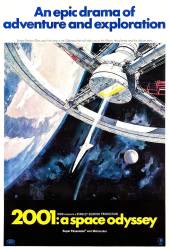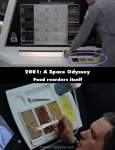Corrected entry: When Frank goes to retrieve the failing AE-35, he stops the pod hundreds of yards from the ship and floats his way to the ship. If I were doing this, I would park 10 feet from where I needed to go to avoid the possibility of missing my target and getting lost in space.
Corrected entry: Moon Watcher, inspired somehow by the Monolith, invents the club. Presumably, it's the first invention ever. He imagines clubbing a herbivore. In the next scene, he brings skabs of meat to his buddies. But he had neither a knife nor any skill in butchering. He could not have cut up the carcass.
Correction: Wild chimpanzees, baboons and other primates kill their prey and tear them to pieces with their hands. Smashing a leg bone (with a club) would make the flesh relatively easy to remove.
Corrected entry: After HAL kills Poole we see his body cross paths in an X with the spinning away pod, as if they originated in two different locations.
Correction: Anything could have affected his trajectory and that of the pod, like a ruptured air line (we see him frantically trying to plug one back in) or he could have bounced off the hull or any of the structures on the Discovery.
Corrected entry: When Bowman blows the pod hatch and is ejected by the air into the ship's airlock, Newton's First Law dictates that the pod should move in the opposite direction, away from the ship.
Correction: Already posted and corrected - The pod would be weightless in outer space but it still has mass and inertia. The total change in momentum of Bowman and the air escaping from the pod, applied to a pod with about the mass of medium sized car, would result in the pod moving away at only about 50cm per second. That would be barely noticeable from our point of view, even if the change wasn't immediately corrected by an auto-pilot mechanism, which is feasible. We can calculate the reaction speed of the pod this way : assume a gas volume of 4 cubic metres, a mass for the pod of 2500 kg, a mass for Bowman of 150 kg, an average delta v of 100 m/s for the air in the pod, and a delta v of 10 m/s for Bowman - all of which yields a result of 0.5 m/s, and if air pressure in the pod were lower it would have moved even more slowly.
Corrected entry: When Dave is overflying Jupiter (on the left side of the screen, in the center), we see animals climbing up the hills. (02:10:42)
Correction: I just replayed this shot multiple times off my Blu-ray. I see nothing that looks remotely like "animals" climbing the mountain. 1) If there is something there, it requires freeze framing and/or zooming to see, therefore invalidating the error. 2) Considering the scale of the shot, I can't imagine anything smaller than a Brontosaurus being visible. 3) Dave is not flying over Jupiter. Jupiter is a gas giant with no solid surface. He has travelled through an interdimensional gateway. What do you think the eight minutes leading up to this shot were about?
Corrected entry: When Bowman and Poole get into the pod they have HAL spin it around for seemingly no other reason than to allow HAL to read their lips through the window.
Correction: They are giving HAL random orders to make sure he is obeying them. They have no idea he is going to be able to read their lips through the porthole so it does not form part of their planning.
Corrected entry: Early in the movie, when the Aries moon shuttle touches down on the covered/shielded landing platform, a considerable amount of dust is kicked up by the engines. But with no atmosphere to blow dust around, it couldn't have blown in from the moon's surface and since this is seemingly the only landing site at the base, it wasn't caused by other landers. Nice effect, though.
Correction: Watch the scene again - that's not dust. It is rocket exhaust from the Aries moon shuttle itself.
You may be correct! I'll have to withhold judgement till I see the movie again.
Corrected entry: When the explosive bolts blow as Dave Bowman is about to be exposed to the vacuum of space, entering the emergency airlock, wouldn't his eardrums have been blown by the explosive bolts going off in that cramped and pressurized pod? And wouldn't he be so severely eyesight impaired due to the fluid boil-off in his eyes in a vacuum, that he wouldn't be able to see, let alone operate the emergency door control lever in the airlock which he just happened to conveniently end up at? This scene looks wrong.
Correction: Since that same scenario happened in a 1960s Mercury program capsule to astronaut Gus Grissom without ear damage, we can assume that the technology of 2001 would also not damage Bowman's ears. Likewise, all astronauts on Skylab and International Space Station were trained to find and operate all hatches in the dark. Bowman should have been able to operate the airlock with his eyes closed or blinded.
Correction: As for eyes being useless in a vacuum, tell that to Jim Leblanc, a NASA technician who was accidentally exposed to vacuum for 27 seconds during a space suit test in 1966. He reported a slight earache, a loss of his sense of taste, but no problems with his eyesight.
Revealing mistake: When Dave Bowman attempts to re-enter Discovery One via the emergency airlock after blowing the explosive bolts on the pod door, where does said pod door go? And also, because of Newton's law of motion, the sudden rush of cabin air during decompression inside said pod after the bolts had blown the door off would have resulted in the pod being pushed in the opposite direction (in effect, that rapid escaping air would have acted like a rocket motor, propelling the pod like a cannonball from a gun!).
Suggested correction: Did you watch the film? The pod bay door doesn't come into it. Bowman enters via the emergency entrance, not a pod bay. The door of the pod and the door of the emergency exit slide sideways into cavities that are there for that purpose - hinged doors don't make any sense in a cramped spacecraft. We see the emergency entrance doorway slide back into position when Bowman activates it.
I think you confused the pod bay door with the door on the pod itself. In the explosive bolt sequence, the pod door does disappear. There is an expanding cloud from the pod door, but no flying door or evidence of it in the emergency airlock. Just an open hole in the pod.
In the scene just before HAL reads the astronauts' lips in the pod, we see that the pod door does slide sideways into the pod hull. The explosive bolts, marked by small red patches, are located in a pattern all around the edge of the door. This indicates that the explosive bolts would blow that section of the door outward rather than sideways into the hull storage pocket.
Bowman programmes the bolts on one side of the door only to detonate, blowing it sideways.
Sure, that might work, but how about this? Bowman knows that the door is constructed of a special composite material that instantly vaporises if it is compressed in just the right way. So, he reprograms the charges to set up a harmonic series of shock wave fronts that destabilises the composite of the door structure, tuning it into the large cloud of smoke we see in the scene.
Corrected entry: The scene at the Tycho excavation site where the uncovered monolith emits a radio signal after being illuminated by the rising sun incorrectly shows the sun directly overhead. This would be impossible as the crater Tycho is in the moon's southern hemisphere and the sun would never rise that high during the lunar summer.
Correction: When is it ever specified that this scene takes place in the lunar summer?
Trivia: People speculate that HAL is a reference to IBM, as the letters differ by one position. Kubrick says this is a coincidence, but was concerned about IBM's reaction to the film's references, including the IBM logo on Bowman's spacesuit. However IBM had no problem as long as they weren't associated with the "equipment failure," or listed as technical advisors for the computer.
Suggested correction: Despite decades of rumors regarding the relationship between Kubrick's "2001: A Space Odyssey" and IBM, the fact is that IBM worked very closely with the production (assisting and advising on futuristic onscreen computer effects), and there was never any conflict or concern with IBM's reaction to the film.







Correction: This isn't a mistake - it is you second guessing the film. What you would have done in Poole's place is irrelevant. We have no idea about the logistics of a maintenance mission carried out on a fictional space craft on its way to Jupiter - it has never happened and it is very likely it never will. Not knowing the reasons for Poole parking the pod where he did doesn't mean there isn't one.
I'm not second guessing the film, just the logistical decision Pool made. Makes no practical sense, filmmaking not withstanding.
steven_frankel